Color, Light and Shadow Amongst the Floodplain Cottonwoods and Sycamores
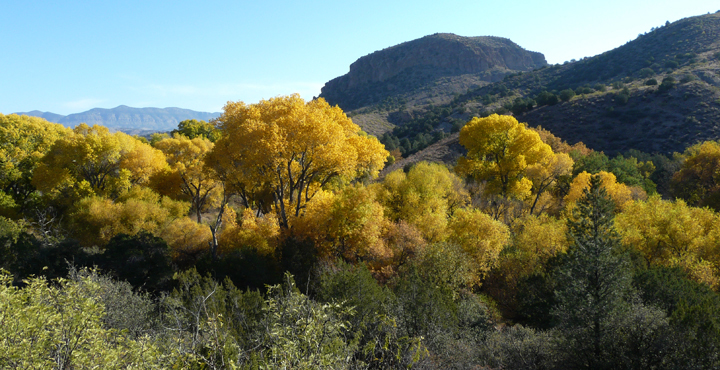
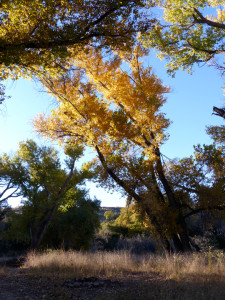
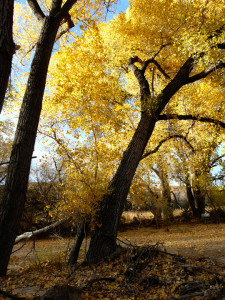
Each year between the last two weeks of October and the first two weeks in November, visitors to Casitas de Gila Guesthouses are treated to the annual visual feast of color, light, and shadow along the floodplains of Bear Creek in front of the Casitas and at the nearby Gila River Riparian Preserve in the Gila National Forest.
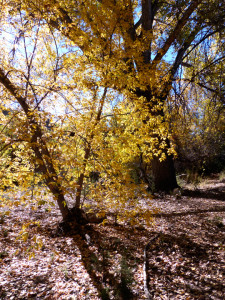

By Late October and Early November, the bright cerulean-blue skies of Summer are in transition to the deeper cobalt blues of Winter as the Sun arcs ever closer to the southern horizon. At this time the deep verdant greens of the dense riverine forest of Cottonwood, Sycamore, Willow, Ash, and Walnut are transformed into an evolving kaleidoscopic display of varying shades and tones of yellow, orange, red, brown, and purple as each of the species responds in its own way to the increasingly colder nighttime rivers of air that flow down into the canyons from the lofty mountain peaks of the Gila Wilderness to the north.
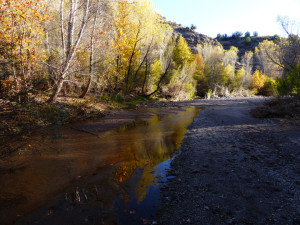
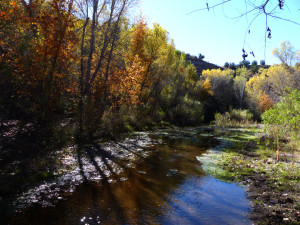
Depending on the year, the time of transition from first coloring to that final blaze of glory for each of the species can be prolonged or remarkably all-too-short depending on the vagaries of temperature, precipitation, wind, and controlling weather systems. This year the change was gradual and prolonged in response to a strong El Niño weather pattern dominating over the southwest, bringing milder temperatures and above-normal precipitation.
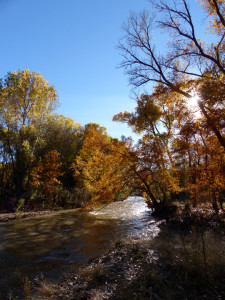
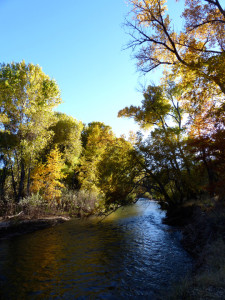
One of the greatest joys of living surrounded by nature at the Casitas is the opportunity to visit and observe the same sites along Bear Creek and the Gila River on a frequent daily basis throughout the year and at different times of the day. Typically, the changes are slow, the change measured in weeks. However, come Fall and the coloring of the leaves, the changes are measured in days, especially towards the end of this month-long process. At this time the rate of change gradually accelerates to literally overnight transformation as Mother Nature completes her annual tapestry in color and signs it with an artistic flourish.

Cottonwoods (Populus fremontii) are typically the dominant floodplain tree along Southwest New Mexico rivers and creeks. When their fall colors are at their peak, Bear Creek Canyon and the nearby Gila River Valley are literally transformed into rivers of gold. Taking a quiet walk within a mature grove of floodplain Cottonwoods on a warm afternoon at this time of year is to experience the essence of the Old Southwest, of times long ago when most of these river and creek valleys served as the primary trails and early roadways for the peoples of the Prehistoric and Pioneer Southwest. To pause and sit beneath one of these ancient Cottonwoods in the pervading silence will only heighten the experience … listen to the wind rustling high above in the upper branches; watch as the golden leaves spiral down to coat the canyon floor, their trunks reflecting in the still waters of the creek. Remain there for a longer time and perhaps the snapping of twigs will herald the approach of a trio of young Mule Deer, or possibly a furtive Bobcat on its way for a drink at the creek …
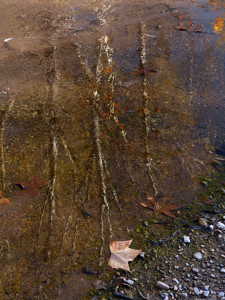
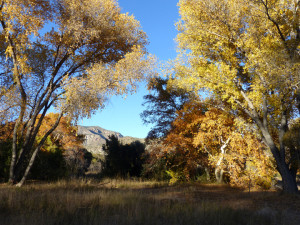
Be assured that Mangas Coloradas, Geronimo, Victorio, Naiche, and the other Apache chiefs and their people passed where you sit on such an afternoon not all that long ago, for this was their homeland … the heart of Apacheria. And a few hundred years before the Apache, the Mogollon People were harvesting their crops of maize, squash, and beans on the first terrace above the floodplain, perhaps just across the stream from you. It is reported that for some people, their presence is still sensed here.
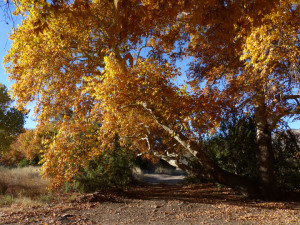
Once the Cottonwoods pass their peak of color, the Sycamores (Platanus wrightii) then emerge in striking visual accent and counterpoint from the mass of Cottonwood Gold, their russet-red star-shaped leaves and bone-white trunks and limbs set against the cobalt blue sky. For the photographer or landscape painter the sycamores are a special delight, particularly when their reddish leaves and white branches are reflected in the waters of the passing stream.
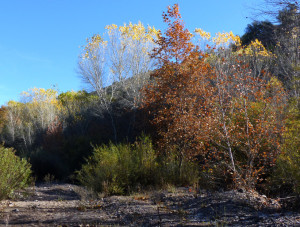
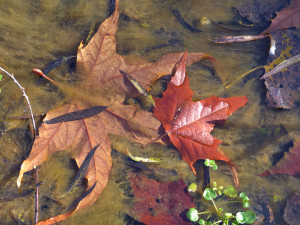

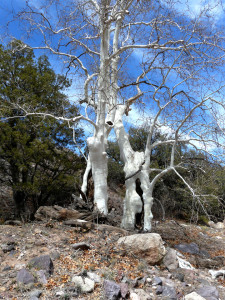
On some creeks, such as the lower reaches of Little Dry Creek a few miles upstream from its junction with the San Francisco River, Sycamores are the dominant floodplain tree, replacing most, if not all, of the Cottonwoods. The reason for this change is readily discerned in the gnarled and battered appearance of their trunks and lower branches. For where Sycamores are found to dominate, one quickly observes that these are high gradient, high energy creeks; creeks that are often the scene of raging floods and flash floods that stem from Springtime melting snows and Summer Monsoon thunderstorms in the nearby soaring mountains.
Torrential floods transport large volumes of coarse sediment and gravel. Often they carry boulders as big as small cars that crash into the Sycamores, gouging big holes in their trunks, and occasionally washing or tearing away all of their roots, causing them to fall. But many Sycamores can stand this perennial onslaught of Nature and grow to great size and age. Sycamores are much tougher and harder than Cottonwoods, which, even if by chance were to germinate and start growing here in these rocky canyons during a cycle of years of less severe flooding, would be quickly eliminated when the big floods occur.
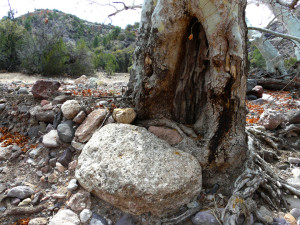
Frequently, one of these ancient and gnarled Sycamores will be observed growing around and beginning to encapsulate one of these huge flood-carried boulders. Often it appears as if the tree is in the process of digesting the boulder. Oh yes, these deep canyon Sycamores are without a doubt the Warrior Giants of the floodplain forest, and they proudly display their battle scars for all who choose to pass here as proof of their prowess.
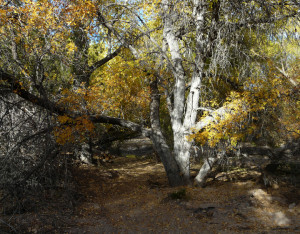
Along the banks of calmer creeks, such as Bear Creak, a variety of Willows (Salix sp.), Velvet Ash (Fraxinus velutina), and Arizona Walnut (Juglans major) grow to more modest size in comparison to the Cottonwoods and Sycamores. These smaller shrubs and trees present a variety of colors from yellow to orange and red to purple which provide both visual harmony and counterpoint accents to the larger and taller Cottonwoods and Sycamores. These trees almost always color and lose their leaves earlier because of their closeness to the floodplain floor where the cold nighttime air flowing down the canyons is often 10 to 15 degrees colder than the upper branches of the floodplain Cottonwoods and Sycamores.
FALL ENCHANTMENT IN SOME SPECIAL PLACES IN THE GILA RIVER COUNTRY OF SOUTHWEST NEW MEXICO, NOVEMBER 2015
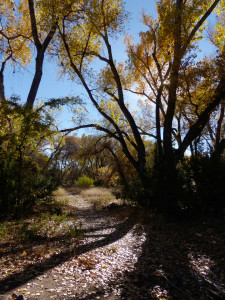
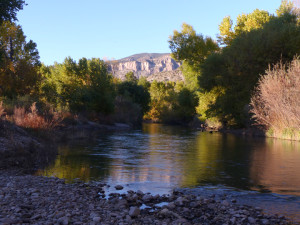
Over time, as one becomes familiar with the various segments of a particular creek or river, one eventually will come to recognize some “special places” — unique places where the balance and harmony of Nature’s landscape is perfect in every aspect. These are the uncommon places for which the Naturalist, photographer, or landscape painter blindly seek, but instantly know when encountered — places that cannot be summoned or set up, but, at that moment, just are.
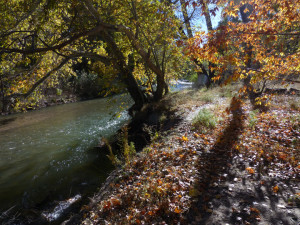
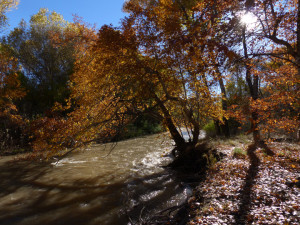
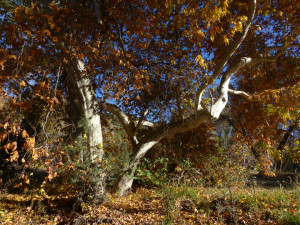
A few of these places have an extended timelessness in which their specialness prevails and can be savored slowly again and again; however, most do not. No, for most of such places, this ineffable specialness is fleeting, often measured in mere minutes as the play of light and shadow transforms the common into a brief perception of the Divine. These are the true treasures of Nature, and in Southwest New Mexico during those few weeks of Fall Enchantment from Late October to Mid November is when they are most likely to be found … and they wait for you here every year.



